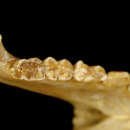pt-BR
nomes no trilho de navegação


Indriids are known from Pleistocene fossils.
Like other primates, indriids rely heavily on vision for finding food, navigating, and in communication. Indriids have excellent, binocular vision. Woolly lemurs are nocturnal and have excellent vision in low light. Vocalizations play an important role in social communication as well. Indris sing melodious songs that can be heard up to 2 km away. Members of groups often sing together. It is thought that vocalizations serve to advertise territories, maintain contact between group members, and convey information on age, sex, and reproductive condition of individuals. Avahis and sifakas also use vocalizations extensively in territorial advertisement and distance communication. In fact, the name "sifaka" comes from the explosive sound they make in response to threats, sounding like "see-fak." The sound is accompanied by a rapid jerk of the head and is often given several times in quick succession. Scent marking has been reported in sifakas.
Communication Channels: visual ; tactile ; acoustic ; chemical
Other Communication Modes: choruses
Perception Channels: visual ; tactile ; acoustic ; chemical
All Malagasy primates are threatened, primarily by habitat destruction. Indriids are protected by law in Madagascar, but habitat destruction continues. Indris are also protected by local custom.
There are 11 species in 3 genera in the family Indriidae. The most diverse group are the sifakas (Propithecus), with 7 species. There are also 3 species of woolly lemurs (Avahi) and 1 species of indri (Indri). As in other lemuroid families, species diversity in Indriidae has increased substantially in recent years, going from 5 species recognized in 1991 to 11 in 2005.
Indriidae includes 5 recently extinct genera, representing 7 species. These species became extinct between 500 and 1,000 years ago. The extinctions of all of these species are thought to be directly related to environmental disruptions and hunting by humans soon after their immigration and expansion on Madagascar.
There are no known negative effects of indriids on humans.
Indriids are important members of their native ecosystems. The unique nature of indriids means they are the focus of ecotourism activities that benefit local people. Indriids are also kept in zoos and are the focus of research on evolution.
Positive Impacts: ecotourism ; research and education
Indriids are important folivores in their native ecosystems, impacting plant communities.
All indriids are vegetarians, eating leaves, buds, fruit, bark, and flowers. They occupy a plant-eating primate niche that is occupied by howler monkeys in the neotropics and and leaf-eating monkeys in Africa and Asia. Their salivary glands are enlarged, as in African and Asian leaf-eating monkeys.
Primary Diet: herbivore (Folivore )
Indriids are endemic to Madagascar.
Biogeographic Regions: ethiopian (Native )
Other Geographic Terms: island endemic
Indriids are found in forests and scrublands throughout Madagascar. Species are found in rainforests and deciduous and evergreen forests, typically in forests with large, mature trees.
Habitat Regions: tropical ; terrestrial
Terrestrial Biomes: forest ; rainforest
A captive Propithecus coquereli lived for 30.5 years. Other Propithecus species have lived for more than 20 years in captivity.
Indriids are morphologically diverse, from indris, the largest living strepsirhine species at up to 10 kg, to 1 kg woolly lemurs. Indris have only a stump of a tail and silky fur, while other indriids have long tails. Woolly lemurs have thick, woolly fur and small ears almost concealed in the fur of their head. Sifakas have long, thick fur dorsally which becomes sparse on their underside. They lack fur on the face. Pelage color varies considerably among species, from striking black and whites to browns and yellows. Their faces are somewhat shorter than lemurs and the legs are about 1/3 longer than the arms. The last 4 digits of the feet are joined together with flaps of skin and they act as a single unit in opposing the first toe. Females have a single pair of mammae, a baculum is present in males, and the dental formula is: I 2/2, C 1/0, PM 2/2, M 3/3. Sometimes the dental formula is interpreted as: I 2/1, C 1/1, PM 2/2, M 3/3. The lower toothcomb is made up of 4 teeth, rather than 6 as in lemurs. There is no recognized sexual dimorphism.
Other Physical Features: endothermic ; homoiothermic; bilateral symmetry
Sexual Dimorphism: sexes alike
The only native predator of lemuroids in Madagascar are fossas (Cryptoprocta ferox). Humans also hunt indriids.
Known Predators:
There is relatively little known about indriid mating systems. Males in at least some sifaka species become aggressive in breeding seasons, with fights between males sometimes resulting in serious injuries. Adult males may also exhibit "roaming" behavior during the mating season and competing for access to females. Females allow mating only by males that become dominant during the breeding season.
Single young are born to all indriid species at intervals of 1 to 3 years. Gestation periods are from 130 to 150 days and weaning occurs at up to 180 days after birth. Births are generally seasonal. Sexual maturity occurs at up to 36 months old.
Key Reproductive Features: iteroparous ; seasonal breeding ; gonochoric/gonochoristic/dioecious (sexes separate); sexual ; viviparous
Females care for, nurse, and protect their young in small family groups. Males in family groups may also directly or indirectly care for young, but there is little information on parental investment in the literature. Males are most often responsible for territorial defense, which may impact resources available to females and their dependent offspring. Young may also remain part of family groups for extended periods.
Parental Investment: altricial ; pre-fertilization (Provisioning, Protecting: Female); pre-hatching/birth (Provisioning: Female, Protecting: Female); pre-weaning/fledging (Provisioning: Female, Protecting: Male, Female); pre-independence (Protecting: Male, Female); post-independence association with parents